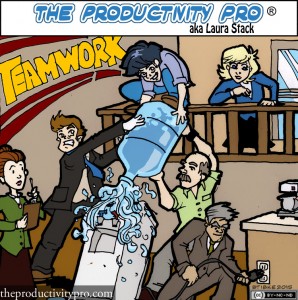 By the time we’re in grade school, our teachers heavily emphasize the value of teamwork: “there’s no ‘I’ in team,” “play well with others,” “class participation is part of your grade.” And there’s nothing wrong with any of that—childhood is rehearsal for life. Play and education are a kid’s jobs, because these activities socialize us into our culture, help us learn how to handle other people, and teach us what adults expect of us as we mature. They also prepare us for the reality of working for a living, where few of us accomplish anything entirely alone.
By the time we’re in grade school, our teachers heavily emphasize the value of teamwork: “there’s no ‘I’ in team,” “play well with others,” “class participation is part of your grade.” And there’s nothing wrong with any of that—childhood is rehearsal for life. Play and education are a kid’s jobs, because these activities socialize us into our culture, help us learn how to handle other people, and teach us what adults expect of us as we mature. They also prepare us for the reality of working for a living, where few of us accomplish anything entirely alone.
On the other hand, some cultures also urge us to be self-reliant, to pick up the slack where no one else will, to be our own people, to work hard for our own goals. The U.S., Britain, Australia, Denmark, and Holland are a few examples among many. Speaking from experience, this holds especially true for entrepreneurs and the self-employed. Been there, done that, have a whole drawer full of T-shirts.
Granted, teamwork isn’t always required. Furthermore, for some things just take too long with the teamwork approach. Team decisions are decisions by committee, and may require hours or days to work through, especially with a new task unfamiliar to the team. Joint decisions and high levels of collaboration aren’t always necessary anyway. You just have to know when to make an “executive decision” vs. getting input or asking permission. The bigger and more significant the decision, the more likely you should ask for help or kick it up the ladder.
But there are many times where you just want to do things yourself and act independently, san team. Perhaps you have one of those supervisors for whom every task has equal priority, you have no choice but to prioritize them yourself. Or suppose you’re out of contact with leadership and don’t know what they want you to do next—or a crisis occurs, and you’re not sure you have time to wait for leadership to make the decisions. There will also be times when you have no choice but to strike when the iron is hot or lose a profitable opportunity, in which case you can beg for forgiveness because there was no time to ask for permission.
Then there are the everyday things you can’t let yourself bog down on: what’s next when you finish one task, how to do something new, or whether or not to stay an extra hour to catch up. You don’t consult the team for those.
When you have guidelines in place to ensure individual workflows mesh smoothly, you can all do your own thing, making most of your own decisions, and still function well as a team. If something goes wrong with team workflow, don’t wait for someone else to fix it; wade in and do it yourself. You can inform your supervisor of your decision later.
Teamwork remains the basis of modern business. But the best teams consist of individuals comfortable with and skilled at making the everyday, individual decisions required to keep the team up and running—while being willing to reach out and make the bigger ones when necessary. Take the initiative. Make a decision. Don’t use “collaboration” as an excuse not to do the work.
© 2015 Laura Stack. Laura Stack, a.k.a. The Productivity Pro®, helps professionals achieve Maximum Results in Minimum Time®. For nearly 25 years, her keynote speeches and workshops have helped professionals and leaders boost personal and team productivity, increase results, and save time at work. Laura is the author of seven books by large publishers. Her newest book, Doing the Right Things Right: How the Effective Executive Spends Time, hits bookstores in January. Widely regarded as one of the leading experts in the field of performance and workplace issues, Laura has been featured in the Wall Street Journal, the New York Times, and USA Today. Connect via her website, Facebook, or Twitter.


